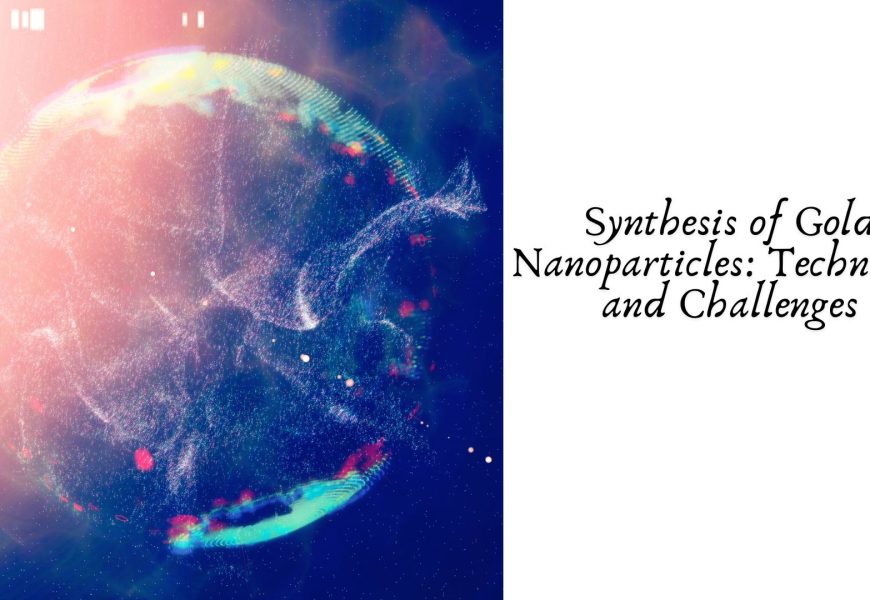Gold nanoparticles (AuNPs) have gained significant attention in various fields, including biomedicine, catalysis, electronics, and environmental science. These nanomaterials, composed of gold atoms at the nanoscale, exhibit unique physical, chemical, and optical properties compared to bulk gold. Due to their distinctive characteristics, AuNPs have been extensively researched, and a range of synthesis methods have been developed. However, each technique comes with its own set of challenges. In this article, we will explore the various methods of synthesizing gold nanoparticles, their applications, and the associated challenges that researchers and industries face.
Introduction to Gold Nanoparticles
Gold nanoparticles are defined as particles of gold with diameters typically ranging from 1 to 100 nanometers. At the nanoscale, gold undergoes several changes in its physical properties, such as surface plasmon resonance (SPR), which makes AuNPs highly useful in applications like imaging, drug delivery, biosensing, and environmental remediation.
The synthesis of AuNPs is a critical aspect of their functionality, as the size, shape, and surface characteristics of the nanoparticles directly affect their properties. Several methods have been developed to control these parameters, but achieving precise control over particle size, uniformity, and dispersibility remains a challenge.
Synthesis Techniques for Gold Nanoparticles
The synthesis of AuNPs can generally be classified into two broad categories: top-down methods and bottom-up methods. Both methods have their advantages and limitations, which are discussed below.
Bottom-up Methods
Bottom-up approaches involve the assembly of smaller units (atoms or molecules) into larger nanostructures. These techniques typically offer more control over the size and shape of the nanoparticles.
Chemical Reduction Method
The most widely used method for synthesizing gold nanoparticles is the chemical reduction method. In this approach, a gold salt (usually gold chloride, HAuCl₄) is reduced to metallic gold (Au) by a reducing agent, such as sodium citrate, sodium borohydride (NaBH₄), or ascorbic acid. The reduction process results in the formation of nanoparticles with varying sizes, depending on the concentration of the reducing agent, the gold precursor, and other reaction conditions.
Advantages:
- Simplicity and cost-effectiveness.
- Control over particle size by adjusting reaction conditions.
Challenges:
- Difficulty in achieving uniform particle sizes.
- The need for precise control of the reducing agent to avoid aggregation or the formation of irregular shapes.
Seed-Mediated Growth Method
In the seed-mediated growth method, small gold seeds are first synthesized using the chemical reduction method. These seeds act as templates for the growth of larger gold nanoparticles when additional gold salt is added under controlled conditions. The size and morphology of the nanoparticles can be controlled by adjusting the ratio of seed to gold precursor, the temperature, and the reaction time.
Advantages:
- Provides better control over nanoparticle size and uniformity.
- Ability to produce gold nanoparticles with specific shapes (e.g., spherical, triangular, or rod-like).
Challenges:
- Requires careful control of the seed size and growth conditions.
- Can be labor-intensive and time-consuming.
Photochemical Reduction
This method utilizes light (usually ultraviolet light) to reduce the gold salt. When gold salt is irradiated with UV light in the presence of a reducing agent, it leads to the formation of gold nanoparticles. This approach can be advantageous when aiming for smaller-sized nanoparticles.
Advantages:
- Suitable for large-scale synthesis.
- Environmentally friendly compared to chemical reduction methods that use toxic reducing agents.
Challenges:
- Less control over particle size and shape compared to chemical reduction.
- High energy input required for photochemical reduction.
Top-down Methods
Top-down methods involve breaking down bulk materials into nanoscale particles. These methods are generally more complex and require precise control to achieve nanosized particles.
Laser Ablation
In laser ablation, a gold target is irradiated with a high-powered laser in a liquid medium, causing the gold to break apart and form nanoparticles. The size and shape of the nanoparticles depend on the laser parameters, such as pulse duration, intensity, and wavelength.
Advantages:
- Produces high-purity nanoparticles with minimal use of chemicals.
- Capable of producing a variety of shapes.
Challenges:
- The process can be slow and requires expensive equipment.
- Difficult to scale up for large-scale production.
Challenges in Gold Nanoparticle Synthesis
While gold nanoparticles have a broad range of applications, synthesizing them remains a complex task. Several challenges hinder the reproducibility, scalability, and functionality of AuNPs.
Particle Size and Uniformity
Achieving uniformity in nanoparticle size is crucial for many applications, such as drug delivery and catalysis. Variations in size can lead to inconsistent behavior in chemical reactions or biological interactions. Controlling the particle size distribution remains a significant challenge in most synthesis methods.
Shape Control
Gold nanoparticles exhibit a variety of shapes, including spheres, rods, and triangles, each of which has unique properties. However, controlling the shape of nanoparticles consistently is difficult, as small changes in synthesis conditions (e.g., precursor concentration, temperature) can result in significant morphological differences.
Aggregation and Stability
Gold nanoparticles tend to aggregate due to van der Waals forces or electrostatic interactions between particles. Aggregation can lead to a loss of their unique properties and hinder their performance in practical applications. Stabilizing gold nanoparticles through surface modification (e.g., with ligands or surfactants) is necessary but adds complexity to the synthesis process.
Scalability
Scaling up the synthesis of gold nanoparticles from the laboratory to industrial-scale production presents significant challenges. Methods that work well at a small scale, such as laser ablation, often become inefficient and expensive when scaled up. Ensuring uniformity and maintaining control over particle size and shape during large-scale production requires optimization of synthesis methods.
Environmental Impact and Safety
The synthesis of gold nanoparticles often involves the use of chemicals that may be toxic or environmentally harmful. In recent years, researchers have been focusing on green synthesis methods, using plant extracts, microorganisms, or other environmentally friendly reducing agents. However, these methods are still in the experimental stage and may not yet be suitable for large-scale production.
Applications of Gold Nanoparticles
Gold nanoparticles are incredibly versatile and have applications across various industries:
- Biomedical Applications: AuNPs are used in drug delivery, diagnostics, and imaging due to their biocompatibility and the ability to functionalize their surface with targeting molecules.
- Catalysis: AuNPs have shown promise in catalytic reactions, particularly in areas like hydrogenation and oxidation processes.
- Environmental Applications: AuNPs are being explored for environmental monitoring and water treatment, as they can adsorb pollutants and toxic substances.
- Electronics and Sensors: Due to their unique optical properties, gold nanoparticles are used in sensors and electronic devices, such as biosensors and flexible electronics.
Conclusion
The synthesis of gold nanoparticles is a rapidly evolving field, with numerous methods available to create these highly functional materials. While bottom-up techniques like chemical reduction and seed-mediated growth offer control over size and shape, challenges such as aggregation, uniformity, and scalability persist. Top-down methods, such as laser ablation and ball milling, are useful but are often limited by their scalability and efficiency.
Researchers continue to explore new ways to address these challenges, particularly by developing environmentally friendly synthesis methods. The future of gold nanoparticle synthesis will likely see advancements that allow for large-scale, reproducible, and sustainable production, unlocking even more applications for these remarkable nanomaterials.









